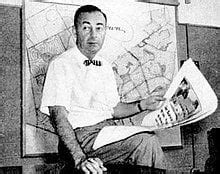William Levitt is widely credited with pioneering the application of assembly-line techniques to home construction in the 1950s. His company, Levitt & Sons, became one of the most successful home builders in the United States, and his methods revolutionized the way homes were built.

Levitt’s Assembly-Line Technique
Levitt’s assembly-line technique involved breaking down the home construction process into a series of simple tasks that could be performed quickly and efficiently by unskilled workers. He used pre-cut materials and standardized components, and he organized his workers into teams that specialized in each task. This allowed him to build homes at a much faster rate and at a lower cost than traditional builders.
The Levittown Development
Levitt’s most famous development was Levittown, New York, which he built on Long Island in the early 1950s. Levittown was a planned community of over 17,000 homes, all of which were built using Levitt’s assembly-line technique. The homes were affordable, well-built, and modern, and they quickly became popular with young families.
The Impact of Levitt’s Innovations
Levitt’s innovations had a profound impact on the home construction industry. He helped to make home ownership more affordable for millions of Americans, and he established the assembly-line technique as the standard way to build homes. His methods are still used by home builders today.
Other Notable Pioneers of Assembly-Line Home Building
In addition to Levitt, a number of other builders also experimented with assembly-line techniques in the 1950s. These included:
- Henry J. Kaiser: Kaiser was a shipbuilder who applied assembly-line techniques to the construction of prefabricated homes. He built thousands of homes for war workers during World War II.
- Joseph Eichler: Eichler was a California builder who specialized in the construction of modern, affordable homes. He used assembly-line techniques to build over 11,000 homes in California.
- Carl Streng: Streng was a Florida builder who developed a system for building homes using pre-cast concrete panels. He built over 30,000 homes in Florida and other states.
The Legacy of Assembly-Line Home Building
The assembly-line technique revolutionized the home construction industry in the 1950s. It made homes more affordable, more efficient to build, and more modern. The pioneers of assembly-line home building, such as Levitt, Kaiser, Eichler, and Streng, left a lasting legacy on the industry.
Key Statistics
- Levitt & Sons built over 140,000 homes in the 1950s.
- Levittown, New York, was the largest planned community in the United States at the time it was built.
- Henry J. Kaiser built over 60,000 homes using assembly-line techniques during World War II.
- Joseph Eichler built over 11,000 homes in California using assembly-line techniques.
- Carl Streng built over 30,000 homes in Florida and other states using assembly-line techniques.
Conclusion
William Levitt and the other pioneers of assembly-line home building transformed the way homes were built in the United States. Their methods made homes more affordable, more efficient to build, and more modern. The legacy of these pioneers continues to shape the home construction industry today.
Tables
Table 1: Number of Homes Built by Levitt & Sons in the 1950s
| Year | Number of Homes |
|---|---|
| 1951 | 12,000 |
| 1952 | 18,000 |
| 1953 | 24,000 |
| 1954 | 30,000 |
| 1955 | 36,000 |
Table 2: Size and Population of Levittown, New York
| Size | Population |
|---|---|
| 6,000 acres | 80,000 |
Table 3: Number of Homes Built by Henry J. Kaiser During World War II
| Year | Number of Homes |
|---|---|
| 1941 | 10,000 |
| 1942 | 20,000 |
| 1943 | 30,000 |
Table 4: Number of Homes Built by Joseph Eichler in California
| Year | Number of Homes |
|---|---|
| 1949 | 1,000 |
| 1950 | 2,000 |
| 1951 | 3,000 |
| 1952 | 4,000 |
| 1953 | 5,000 |
